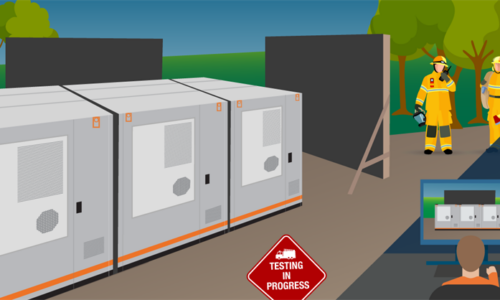Table of Contents
Blesson Thomas, Head of Grid at Clearstone Energy, looks beyond the sensational headlines about Battery Energy Storage safety by reviewing the facts on battery storage safety and the measures being implemented to ensure that projects are safe by design.
How prevalent are battery safety incidents?
There are billions of Lithium-Ion batteries in use around the world. They power a huge range of devices, from laptops to the International Space Station.
Failure rates are incredibly low. Estimates of the probability of the sort of critical failure in a Lithium Ion battery cell that can lead to a fire is 1 in 40 million1. This compares to the odds of being struck by lightning in the UK as around 1 in 10 million or winning the national lottery highest jackpot as around 1 in 4 million.
What causes a lithium ion battery fire?
The process that leads to a lithium-ion battery catching fire is called a thermal runaway. A failed battery cell enters a process of chemical reactions that causes rapid temperature rises within the cell. These chemical reactions generate flammable gases that can then ignite, creating a fire. Thermal runaway can be triggered by an internal failure or external factors such as damage, extreme heat or overcharging.
What safety standards are there for battery energy storage projects?
The number of Battery Energy Storage facilities in the UK is growing quickly in response to the need to store electricity from wind and solar farms. There has already been significant real world fire safety testing and research into previous incidents. The learnings are reflected in extensive standards and guidance governing battery product and site design.
We deliberately made Clearstone Energy’s Battery Safety Standards Plan as comprehensive as possible by including the latest standards from the UK National Fire Chiefs Council (NFCC), the British Standards Institution and the US National Fire Protection Agency (NFPA).

Mitigating fire risks by design
Step 1 – Minimise the risk of an incident occurring
The Lithium Ion batteries used in battery energy storage facilities are designed with multiple layers of fire prevention technology, including:
- Cabinets and enclosures are designed to protect the batteries inside from the impact damage that could cause a battery cell failure.
- Both batteries and cabinets have integrated cooling systems to manage temperatures.
- A sophisticated battery management system (BMS) continually monitors individual battery cells for faults and abnormal temperatures. If anything unusual is detected, the BMS disconnects the enclosure containing that cell and alerts engineers.
- Battery enclosures are fitted with sensors to detect the build-up of flammable gases and automatically trigger an integrating venting system to clear the gases.
Step 2 – Minimise the risk of a fire spreading
In the unlikely event that a battery unit does catch fire, battery enclosures and battery storage facilities are designed to contain the fire to that individual unit.
- Each battery cabinet or enclosure has a fire suppression system. This is automatically triggered as soon as a fire is detected and uses integrated water sprinklers or a gas-based fire suppression system to extinguish or contain the fire.
- Battery cabinets and enclosures are designed to minimise heat transfer so that a fire in one cabinet does not lead to adjacent cabinets overheating.
- Facilities are also carefully designed around standards for the safe separation distances between battery containers and between containers and combustible materials, such as trees and hedges, to prevent a fire from spreading beyond a single battery unit.
Any battery system installed on a Clearstone Energy project will have undergone rigorous real-world testing to demonstrate the effectiveness of its fire suppression and containment systems and will be designed to work without fire service intervention.
The UK National Fire Chiefs Council (NFCC) standards extend to ensuring that a battery energy storage system is designed to enable Fire & Rescue Service (FRS) personnel to tackle any incident effectively. This includes a site layout that provides a secondary access point and unencumbered access to all areas for fire engines and personnel, multiple water hydrants and suitable water supply and easy access to any fire fighting equipment on site.
Along with information about battery technology and system design, all these details are shared with the Local FRS before the site begins operating and a comprehensive Emergency Response Plan will be agreed to support first responders in the event of an incident on site.
Step 3 – Minimise the risk to people, property and the environment
Clearstone Energy’s battery safety standards and best practices extend beyond fire suppression and containment to ensure that people, property and the environment are protected in the event of a fire.
- NFCC guidelines include safe distances from battery units to site boundaries, public footpaths and occupied buildings to ensure that the general public are protected in a fire situation.
- Protecting emergency services personnel is paramount and NFPA guidelines include safe working distances for firefighters and observation points for fire services personnel.
- Battery storage sites are designed with containment and drainage systems to collect firefighting water that can be isolated from the public water courses and sewers in the event of a fire. Water will be contained on site for removal and treatment once the incident has been safely tackled.
Battery safety by design
Clearstone Energy is a prominent and independent UK-based renewable energy company that aims to revolutionise the way we power the UK. As a reference company in a rapidly expanding industry, we hold a significant responsibility in driving safety standards across the industry. With our rigorous safety approach towards all our battery safety projects, we are striving to set a benchmark for the entire industry to follow.
1 Faraday Institution, Research Breakthrough Increases Safety of Lithium-Ion Batteries, September 2023, https://www.faraday.ac.uk/success-stories/research-breakthrough-increases-safety-of-lithium-ion-batteries-2/ ,
